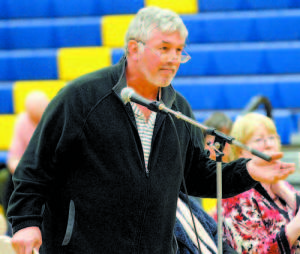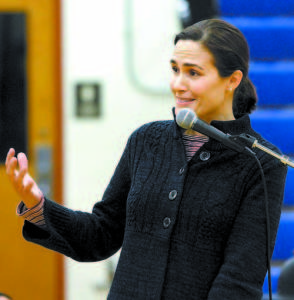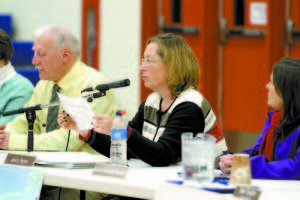CRES project heads to the polls; mixed thoughts expressed at final hearing

POINT — Richard Merrritt of Sebago, a former school board member, supports spending $500,000 to renovate Crooked River School and thus be able to place students there sooner to ease overcrowding at Songo Locks School. (Rivet Photos)
By Wayne E. Rivet
Staff Writer
As residents across SAD 61 took turns at the microphone Tuesday night, at the final public hearing regarding the $9.6 million proposed Crooked River School renovation and construction proposal, varying positions were voiced:
• Friends of Sebago Elementary supporters reiterated their position that they agree a solution is needed to address overcrowding at Songo Locks School. Repurposing Crooked River — back to an elementary school — addresses the problem, but “Friends†members feel the school district can spend under $1 million to prep the facility and move students back into the Route 11 building by next fall.
“Friends†spokeswoman Denise Olsen put it simply, “Too big, too much money.â€
Former Sebago school board member Richard Merritt felt a plan the district considered back in 2013, to renovate the facility for a cost of under $600,000, was a more palatable plan than to shoulder already stressed taxpayers with another huge bond payment over the next 20 years.

COUNTERPOINT — Laura Ordway of Bridgton, who also formerly served on the SAD 61 School Board, commended school officials for their work on the proposed project, and also pointed out to Sebago residents that despite severe financial cuts in state aid over the past six years, SAD 61 has not moved to close their community school.
Allen Crabtree noted that by a 5-2 vote on Feb. 3, 2013, directors approved spending $468,914 to renovate CRES, and later the figure was increased to $557,314. The vote was later rescinded, and the district went back to the drawing board.
The underlying concern voiced several times by Sebago residents was a facility constructed to hold 350 students — 90 more than the projected enrollment of three grades set to occupy CRES in 2017 — could lead to the closure of their community school.
Again, SAD 61 Superintendent Al Smith refuted the claim that he had recommended closure of Sebago Elementary if the Crooked River project passed. He again stated he “valued small schools†and reiterated there have been no formal board discussions about closure.
• PDT architect Steve Blatt gave a quick overview of the project, noting the facility is in dire need of upgrades to meet today’s current standards, such as classroom size from the existing 600 square feet to the current minimum of 800 square feet. The plan calls for 27,000 square feet of renovated space (cost $2,785,000) and the addition of 20,000 square feet of new construction (cost $4,155,000).
“To build a new school over 50,000 square feet, you would be looking at a cost of $15 to $20 million,†Blatt projected. “The improvements being proposed would make this school as good as any in the state.â€
Superintendent Smith pointed out that during community forums he was told by the public to “Do it once, and do it right,†when considering a plan for Crooked River. The project if approved at referendum vote next Tuesday, Dec. 8, Smith said, would meet SAD 61’s educational needs for the next 40 to 50 years.

NOT A SHOWCASE SCHOOL — School Board chairman Janice Barter of Naples listed off elements of the proposed CRES project.
Posted on the SAD 61 website, this is a series of the most Frequently Asked Questions surrounding the proposed construction project to reâ€open the Crooked River School in Casco.
• Why do we need to reâ€open a school that we closed seven years ago? Songo Locks Elementary School currently has 8Â10 portable classrooms. The traffic that accompanies 450-plus students and the staff required has created a daily safety issue. Reopening Crooked River School will cut the student and staff population in half freeing up valuable classroom space and reducing the parking lot congestion.
• Since Crooked River School is 30 years old, won’t it need a lot of work? Although well cared for over the years, Crooked River is in need of this construction/renovation project to meet the students’ educational needs for the 21st century. One hundred percent of classroom and office space will be completely rebuilt. Modernization would include: enhanced library, cafeteria, guidance, and administrative offices; major energy efficiency upgrades; and other building systems upgrades.
• What grades will be served at Crooked River? Grades 3, 4 and 5 would be moved from Songo Locks School to the newly renovated Crooked River School.
• What staffing will need to be added? The personnel from the Songo Locks School will be transferred to the Crooked River School requiring few new hires. To date, SAD 61 knows that officials will be hiring one Special Education teacher for the Day Treatment Program, one custodian, and one additional cafeteria cook.
• Does the public know about the project? Many opportunities have been provided to “spread the word†about this project. Information has been shared by the district through public forums, town board of selectmen meetings, presentations to community groups, mailings of informational brochures, newspaper articles, school board meetings, site visits with the architect and superintendent, and an LRTV panel discussion.
• Why are we building to house 350 when we only have 250 to move into the building? In the first year of operation, it is projected that there will be 250-plus students attending the Crooked River School. A study completed two years ago projected that by this year we would have less than 1,700 students attending our schools. The actual student count is more than 1,810 this year. Building for 350 allows SAD 61 to accommodate this growth.
• Where are the programs currently housed at Crooked River going to go? Adult Education Offices/Classrooms, Special Education Offices, and the high school Alternative Education Program will be moved to the “White House†located behind the vocational center, which at one time, housed many of our vocational programs.
• How much is the project going to cost? The proposed construction project will cost $9.6 million. A similar size renovation/building project was completed at Stevens Brook Elementary School 17 years ago at a cost of $7.3 million.
• How much will my taxes go up if this passes? The annual cost over 20 years is estimated at $650,000 per year including interest costs. Approximate annual cost to each taxpayer per $100,000 home value:
Bridgton = $32.00
Casco = $24.00
Naples = $23.00
Sebago = $12.00
• When is the vote on the project? The referendum vote will take place in all four towns on Tuesday, Dec. 8, 2015. SAD 61 encourages all eligible community members to get out and vote.
• Will Sebago Elementary close as a result on this? The intent of this project was to eliminate overcrowding at the Songo Locks School not to close Sebago Elementary School. We currently educate over 450 students at Songo Locks, which was built to house approximately 380 students.
• Where can I get more information? Additional information can be found on LRTV, on the district website www.lakeregionschools.org , by calling the superintendent’s office, or by speaking directly with any school board member.
Blatt described the 30-year-old school as having “good bones†to work with and a site that has minor issues to address, such as creating a second loop for “bus only†drop-offs. Normally, site work would account for 20% of a project’s cost, Blatt said, but in this case, the amount is 5% (or $550,000).
He pointed out that since new construction would “wrap around†the existing building, the facility would become more energy-efficient.
While some opponents have described the proposed plan as a “showcase†school, Blatt said it is “not fancy†when compared to other facilities across the state.
School Board Chairman Janice Barter attempted to dispel the “showcase school†belief by listing what features the renovated school would include, such as space designated for special services and heating system improvements.
“There is not one frivolous thing in this project,†Barter said.
School officials defended the decision to include an auditorium because the district holds professional development sessions for staff there, and feels a unique opportunity exists to add such a feature that could ultimately be used by community groups, as well.
• Residents took a wide array of positions on the project, including:
Phil Lowe, who is chairman of the Sebago Budget Committee, asked school officials to reveal “real numbers,†such as the project costs $9.6 million, but with interest over 20 years, the final tally will be closer to $13 million, he said. Lowe also wondered by other hidden costs that could arise, such as more staffing.
John Nostin, chairman of the Naples Budget Committee, congratulated school officials on a “job well done†in putting together a solid proposal. He reminded taxpayers that “we can pay now or pay more later†if the project is put off or if the public decides to take a “band-aid†approach regarding CRES. He added there is “a cost†to borrow money, “it doesn’t come free,†and felt taxpayers can give up a few cups of coffee and donuts over a year’s time, if need be, to absorb tax increases to fund the project.
Susan Poulin of Casco offered a “taxpayer’s point of view.†She feels family and neighbors are close to a breaking point in their ability to meet rising tax hikes. She is hopeful the district will attempt to scale back the project.
“If not, I’ll vote ‘No,’†she said. “It’s too expensive.â€
Anne McMahon of Sebago worries that the cost of the CRES project could hamstring other SAD 61 needs, as well as put other programs at risk as school officials pare down future budgets to keep tax increases minimal. She would hate to see SAD 61 resort to “pay-to-play†fees like other school systems have invoked to raise revenues for programming.
Charles Frechette of Sebago pointed out that SAD 61 is a “blue-collar†community, which is struggling to make ends meet. Robert Howe Jr. of Bridgton added that the district has a large number of retired people trying to live off Social Security, which will not increase next year. He pointed out that some economists have forecasted a recession to hit down the road, so SAD 61 should be wary of its debt situation.
Laura Ordway, a former school board member from Bridgton, reminded Sebago residents that despite “crushing†losses of state aid over the past decade ($6 million lost) and a state-mandated consolidation attempt — which ultimately led to SAD 61 repurposing Crooked River and moving kids to Songo Locks as a cost-saving measure — the district did not close Sebago Elementary.
At 9:06 p.m., Phil Shane made the final comments of the night. First, he understands the financial struggles people are contending with. At 72 years old, Shane “still works every day to survive.†Yet, he also strongly believes in meeting the educational needs of the area’s children and believes the Crooked River project is the “right thing to do.â€
“This project is a good investment for our kids,†he said. “I hope people vote for it.â€

